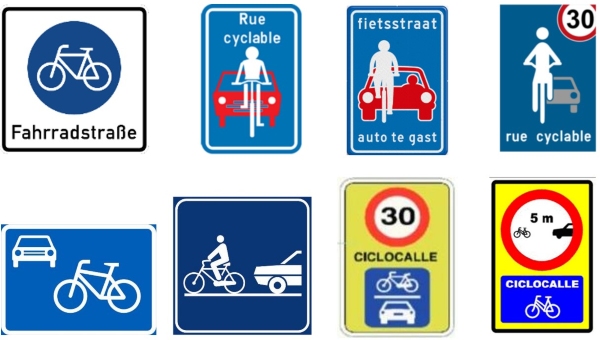
UNECE to develop pro-cycling measures to double cycling levels by 2030 with ECF’s support
UNECE has convened a group of experts, including ECF, to help with the implementation of the infrastructure module of the Pan-European Master Plan for Cycling Promotion. We take a look at some of the key elements being discussed by this group.
After the adoption of the Pan-European Master Plan for Cycling Promotion in May 2021, a group of experts on cycling infrastructure (GE.5) was set up by the United Nations Economic Commission for Europe (UNECE) to help with the implementation of the infrastructural part of the plan. ECF plays an active role in this expert group along with the UNECE Secretariat, UN Member States and representatives of the bicycle industry, Confederation of the European Bicycle Industry (CONEBI) and the World Bicycle Industry Association (WBIA).
Since June 2022, GE.5 has held three meetings to consider ways to develop a trans-European cycle network promoting national cycle route networks, definitions of a bicycle, cycling infrastructures and cycling road signs, in order to make relevant proposals. The most recent versions of documents discussed at the last GE.5 meeting are available on the UNECE website. The next GE.5 session is scheduled to take place in Geneva on 6 and 7 November 2023.

ECF Policy Officer for Infrastructure Aleksander Buczyński speaking during a GE.5 meeting.
Trans-European, EuroVelo and national cycle route networks
The continuity of cycle routes is crucial to enabling equal access to active mobility for all. That is why cycle route networks play an important role in cycling strategies at national and transnational levels.
National cycle route networks are the key for UN Member States to plan prioritised trans-national cycling corridors. But some Member States do not yet have an official cycle route network. That is why GE.5 has been working on a guide to assist these countries in the designation of national cycle route networks.
The group of experts also agreed on common principles to identify a trans-European cycle route network based on national networks which should take EuroVelo as a backbone when relevant, include long-distance routes and enable cross-border connectivity.
25 years of EuroVelo expertise in defining European cycling corridors, together with the experience from Member States investing in the development of EuroVelo and national cycle routes, have been valuable inputs for this work.
Discussions also include requirements for cycle highways and harmonised quality parameters for cycling infrastructure.
Definition of a cycle
Currently, both the 1968 Convention on Road Traffic and 1968 Convention on Road Signs and Signals define a cycle as “any vehicle which has at least two wheels and is propelled solely by the muscular energy of the persons on that vehicle, in particular by means of pedals or handcranks”. This definition strictly speaking does not include any cycles with electrical support, a growing segment of active mobility.
Recognising the problem, the group is working on updating the definition of the cycle and defining subtypes of cycles and/or additional types of pedal-powered vehicles. Ultimately, the goal is to harmonise different approaches across Member States, so that it would be widely recognised what is and what is not a cycle for use at dedicated cycling infrastructure. The group also aims to clarify circumstances under which infrastructure is suitable for vehicles such as speed pedelecs, or wider, commercial cargo cycles, when such are not included in the cycle definition.
Definitions of cycle infrastructure
To discuss cycle infrastructure, we need a common language which follows a common understanding of basic concepts. As for now, the only types of infrastructure with international definitions are cycle track (physically separated) and cycle lane (painted). The group of experts proposed a set of new and updated definitions covering, for example, cycle street, 2-1 road, bus-and-cycle lane and streets with contraflow cycling. The agreed definitions also include solutions specific for intersections, such as advanced stop line, two-stage turn provision or traffic-light exemption for cyclists.

One of the concepts discussed in the group of experts is the 2-1 road – a bidirectional road with two advisory cycle lanes, where the remaining carriageway is not wide enough for two cars.
New signs
The new types of infrastructure also require new signs and road markings. Everyone recognises the cycle track sign – thanks to the harmonisation efforts half a century ago, all countries have the same idea of a pictogram of a cycle on a blue circle in their road sign sets and what it means. But things get more complicated with the new types of infrastructure. For example, at least seven differently designed signs are used to indicate cycle streets across Europe. And even if the signs look similar, the obligations and restrictions that they put on the road users are different! Having a bit less diversity could improve recognisability and understanding of cycle streets and other new cycle infrastructures. The group of experts is working on proposals for new road signs.

Examples of different signs used to indicate cycle streets across Europe.
Updated signals and road markings
The experts also reviewed selected provisions for existing signs, signals and road markings, included in 1968 Convention on Road Signs and Signals. They put forward a few proposals for amendments to the Convention to better take into account current best practices. For example, the proposed amendment for signals improves the legibility of traffic lights for cyclists and adds provisions for directional traffic lights for cyclists, combining signals for pedestrian and cyclists and displaying a confirmation of detection.
Regions:
Topics:
Contact the author
Recent news!
Upcoming events
Contact Us
Avenue des Arts, 7-8
Postal address: Rue de la Charité, 22
1210 Brussels, Belgium









